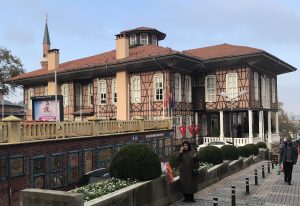
Happily for visitors, many of Bursa’s main sites are right in the centre of town in the area known as Çarşı (the Market). It’s here that you’ll find some of the finest early Ottoman mosques as well as the network of hans that make up the town’s wonderful shopping area, a great alternative to İstanbul‘s Kapalı Çarşi, in my opinion.
Most of the historic monuments are sandwiched between busy Atatürk Caddesi to the south and pedestrianized Cumhuriyet Caddesi to the north along which a tram runs.
Around the Çarşı area
The most obvious monument to use as a landmark for the area is the huge Ulu Cami with its 20 domes and twin minarets. This was erected in 1399 during the reign of Sultan Beyazıt I to mark his 1396 victory in the battle of Nicopolis which is often seen as marking the end of the Crusades. The front of the mosque faces onto the market rather than the road and it’s worth walking round to enter from there not only because that way you will see the mosque’s splendid marble facade but also because you will arrive looking straight at the lovely indoor şadırvan (ablutions fountain) where men but not women can cleanse themselves before praying.
Otherwise the most striking feature of the mosque is the mix of calligraphic inscriptions on the walls and pillars as well as on boards hanging down them. Those who understand Turkish can read translations of some of them on a screen at the front of the mosque. The rest of us can only dream.
Immediately beside the mosque is the Vaiziye Medresi which contains a couple of pleasant small restaurants.
Opposite the entrance to the mosque is the plane-tree-shaded Emir Han which was constructed in 1339 as part of the Orhangazi külliye (see below).
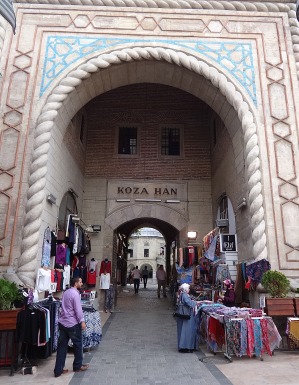 Beside it is the large and lovely Koza Han (Cocoon Han) which was part of the Ulu Cami külliye. Its main entrance is on the far side where it soars up beside a busy shopping street. Its central courtyard is one large plane-tree-shaded tea garden clustered around a mescid raised on stilts above a şadırvan. The two storeys of the han are filled with shops selling silk scarves and other silk items, a relic of the days when the han was the main gathering place for those selling their cocoons to the silk weavers. Unfortunately no cocoons have arrived for sale here since 1994 as the trade has moved back to India and its original Chinese homeland.
Beside it is the large and lovely Koza Han (Cocoon Han) which was part of the Ulu Cami külliye. Its main entrance is on the far side where it soars up beside a busy shopping street. Its central courtyard is one large plane-tree-shaded tea garden clustered around a mescid raised on stilts above a şadırvan. The two storeys of the han are filled with shops selling silk scarves and other silk items, a relic of the days when the han was the main gathering place for those selling their cocoons to the silk weavers. Unfortunately no cocoons have arrived for sale here since 1994 as the trade has moved back to India and its original Chinese homeland.
Kılıç Kalkan Oyunu If you’re in Bursa on a summer Saturday be sure to make your way to the square in front of the Koza Han and beside the Ulu Cami at 6pm to watch men performing the noisy local Sword and Shield Dance. Their efforts will be preceded by a performance by the colourful Mehter Band, the Ottoman marching band that is reported to have terrified those who heard it coming.
This part of town is one complex, interlocking collection of hans joined up these days by streets which have been roofed over to provide protection from the elements. It’s possible to spend many hours here, browsing the shops, pausing for tea in the courtyards and generally soaking up an atmosphere very different from the one in İstanbul. Increasingly, the hans get very busy with locals at weekends. You may arrive to find not a seat to be had in the Koza Han. 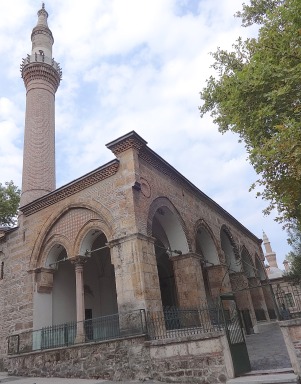
On the opposite side of the Koza Han to the Ulu Cami you’ll see the very different Orhangazi Cami, the first mosque to be erected in Bursa in 1339 and showing off the brick-and-stone style of architecture that was to become a feature of early Ottoman architecture. Internally, it also features the inverted T-shape that was to be widely copied, with worshippers crossing a portico to enter the bar part of the T, with areas on either side that could be used for a variety of functions. The prayer area is up a few steps in front of the mihrab.
Emerging from the mosque you will find yourself gazing on the distinctive two-storey Belediye building, built in 1879 with bricks filling an oak framework. Astonishingly, the name of the architect is unknown.
Heykel and Around
If you walk back up onto the main road and keep walking east you will come to the striking equestrian statue of Atatürk, one of the first to go up in the country and ringed now with some of the city’s lovely spring-flowering Judas trees. Known simply as Heykel (the Monument), it’s a major city landmark.
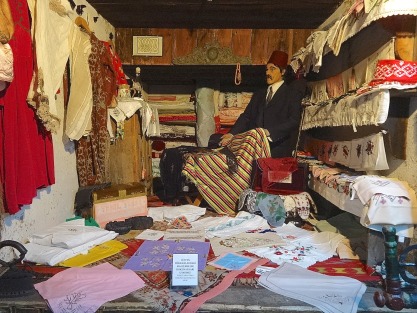 Up the steps behind the Heykel is the Kent Müzesi (City Museum, closed Mondays), one of Turkey’s best local museums, especially for those who can read Turkish. Even if you can’t and the information about the early Ottoman rulers remains mysterious. the reconstructed shops in the basement are well worth seeing for what they tell us about dying crafts. Watch the video showing men beating felt with their knees and you’ll be glad you weren’t born to be a kececi (felter).
Up the steps behind the Heykel is the Kent Müzesi (City Museum, closed Mondays), one of Turkey’s best local museums, especially for those who can read Turkish. Even if you can’t and the information about the early Ottoman rulers remains mysterious. the reconstructed shops in the basement are well worth seeing for what they tell us about dying crafts. Watch the video showing men beating felt with their knees and you’ll be glad you weren’t born to be a kececi (felter).
The top floor hosts changing exhibitions of high quality, usually on local topics such as the impact of immigrants on an area which has a large population of Balkan-born Turks.
Cumhuriyet Caddesi
If you take the steps down beside the Ulu Cami and walk straight ahead through the market you will emerge on Cumhuriyet Caddesi. Turn right and keep walking right to the end to find the Panorama 1326 Bursa Conquest Museum (closed Mondays). Here, beneath a dome, a 360-degree Bruegelesque panorama of Bursa as it was in 1326 when the Ottomans forced the Byzantines out of the city. Despite the name, the emphasis is more on cultural life at the time than on the fighting. Downstairs, large paintings depict aspects of history during the reigns of the six Ottoman sultans to be buried in the city (Osman Gazi, Orhan Gazi, Murad I, Beyazid I, Mehmed I and Murad II).
Close at end stands what may be the only monument in the world to what the British call a ‘bag lady”, in this case Deli Ayten (1935-92).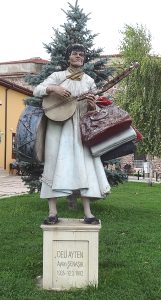
Sleeping
Kent Hotel. Tel: 0224-223 5420
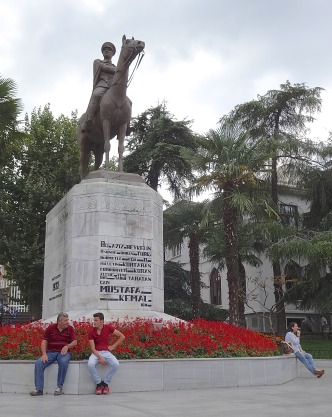 Transport info
Transport info
If you’re staying in the town centre all these attractions will be within easy walking distance although you may have to brave crossing Atatürk Caddesi, the busy main road with its fearsome one-way traffic and almost no traffic lights. The underpasses are fine for the fit and able, an obstacle to everyone else.
Many buses leave from the far side of Atatürk Caddesi. Some dolmuşes leave from near the Ulu Cami, others from Setbaşı which is a little further east than the Heykel. Yet others leave from the Kayıhan Meydani, reachied by heading north along İnönü Caddesi, then heading east through the bazaar.
Nearby areas
“The Hagia Sophia of Bursa.” Evliya Çelebi on the Ulu Cami
Read more about Bursa’s old hans: Exploring the hans of old Bursa


